Studies from North America have shown that lower socioeconomic status is associated with a decrease in regular asthma reviews and an increase in the use of acute asthma-related health resources.1-3 There is a lack of similar research from Australia, and such local data are needed to guide strategic asthma initiatives. There is also a lack of data on regional variations in asthma prevalence. Phase 3 of the International Study of Asthma and Allergies in Childhood (ISAAC) multicountry survey showed that the estimated prevalence of asthma varies widely across time and place.4 Melbourne is the only site in Australia where ISAAC surveys have been conducted repeatedly, and it is not known whether these data are representative of a broader cross-section of Australian children. Finally, we need data on age-related changes in the pattern of asthma in children.
We conducted a survey of asthma prevalence and management among primary school children in the Barwon region of Victoria using the ISAAC protocol. We assessed (i) the effect of socioeconomic status on asthma management and use of health resources; (ii) regional variation in asthma within the Barwon region (comparing with data obtained in Melbourne);5 and (iii) age-related changes in the pattern of asthma during primary school years: whether the switch from male to female predominance in occurrence of asthma symptoms6 begins during primary school; and whether there is an age-related increase in the prevalence of children with very frequent wheeze (≥ 12 episodes) per year.
The study was conducted in the Barwon region of Victoria (Box 1) between March and September 2005. We randomly selected 36 of 91 primary schools (government, Catholic and Independent) within an estimated 90-minute return car journey from the Geelong Hospital. We used a computer-generated random selection method.
We used the ISAAC protocol to survey primary school children from school entry to Year 6.7 The survey instrument was a four-page questionnaire, containing the first of three standard ISAAC modules, which include items related to demographic data and asthma symptoms. A module asking about asthma treatment was added. No translations were supplied.
For comparison data, we used the ISAAC study conducted in Melbourne during 2002.5
We were able to determine the ABS census collection district number for 7408 of the 7813 respondents (94.8%). There was some evidence that disadvantaged children were more likely to have exercise-induced wheeze (P = 0.06), and episodes of asthma severe enough to limit speech to a few words (P = 0.013) (Box 2). However, SEIFA-related trends were not evident for the remaining asthma symptoms (P > 0.05 for each).
Among children with parent-reported wheeze during the preceding 12-month period, disadvantaged children were more likely to have received a regular asthma review with a general practitioner, but were no more likely to have attended an emergency department with an episode of acute wheeze than less disadvantaged children (Box 3). There were no SEIFA-related trends in the proportion of children who had been provided with a written asthma plan (P = 0.81), or who regularly used an inhaled corticosteroid (P = 0.43).
The prevalence of asthma symptoms and asthma-related use of health care resources was similar in coastal, rural and metropolitan zones of the Barwon region (Box 4).
As the ISAAC study conducted in Melbourne in 2002 included 6- and 7-year-old children only,5 we restricted the comparison between the Barwon region and Melbourne to this age group. There was no indication of any differences in the prevalence of asthma symptoms or asthma-related use of health care resources between Melbourne (2002) and the Barwon region (2005) (Box 5).
The proportion of children with parent-reported wheeze during the preceding 12 months was greater among boys than girls (mean difference, 4.2%; 95% CI, 1.9%–6.4%), and this relationship remained relatively constant throughout the primary school years (Box 6).
Among children with parent-reported wheeze during the preceding 12 months, there was an age-related increase in the proportion of children who had very frequent wheeze (≥ 12 episodes per year) (Box 7). However, by contrast, there was an age-related decrease in wheeze-related GP reviews (P < 0.001), emergency department visits (P = 0.02), and hospitalisation (P = 0.04).
As far as we are aware, this is the first Australian study to investigate the relationship between asthma management and socioeconomic status. We have shown that disadvantaged children in the Barwon region, compared with their less disadvantaged peers, access more regular asthma reviews and are no more likely to attend a hospital emergency department with an episode of acute asthma. This finding is novel, and in distinct contrast to data from other parts of the world.1-3
Factors that may be relevant to this novel finding include: access to free medical care in Australia, the activities of the National Asthma Council over recent decades, implementation of the Asthma Friendly Schools Program in 2000 (http://www.asthma.org.au/Default.aspx ?tabid=211), and the Asthma 3+ Visit Plan in 2001 (http://www.health.gov.au/internet/wcms/publishing.nsf/content/health-mediarel-yr2001-mw-mw01102.htm). It is also noteworthy that the Barwon region has a relatively good supply of GPs: 156 full-time equivalents for a population of about 210 000 (Ms Tricia Balane, Workforce Officer, Geelong Division of General Practice, personal communication, 15 May 2007). It would be of interest to examine whether access to regular asthma reviews among disadvantaged children is also adequate in areas of Australia less well served with GPs.
We have also shown that the estimated prevalence of asthma is similar in all three (coastal, rural and metropolitan) zones of the Barwon region when compared with Phase 3 ISAAC estimates conducted in Melbourne during 2002.5 Melbourne appears to be a legitimate sentinel site for asthma monitoring in Victoria, and its population is likely to be representative of a significant proportion of the Australian population.
The age-related data from our study suggest that the switch from male to female predominance in occurrence of asthma symptoms does not occur during the primary school years. Previous studies have shown a female predominance in those with asthma symptoms by the mid-teens.8 Further studies are required to determine the environmental and intrinsic factors that mediate this switch, and these should focus on early adolescence.
Our study has a number of limitations. First, the use of parent-reported wheeze as a primary outcome measure in the ISAAC survey methods lacks specificity,9 and a significant proportion of parents misunderstand the term “wheeze”.10 As a result, ISAAC surveys tend to overestimate the prevalence of asthma. Second, the use of an area-based, rather than an individual-based, classification of socioeconomic status lacks precision: random misclassification of individuals using this approach tends to lead to an underestimate of effect size, and it is possible that we have underestimated socioeconomic trends. Third, the zones that we defined within the Barwon region were relatively arbitrary, and may not be sufficiently different from one another to allow these data to be generalised: the spectra of some exposures are likely to be adequate (eg, airborne pollutants and allergens), but for other exposures (eg, humidity, sunlight) may be relatively narrow.
2 Parent-reported asthma symptoms in children attending primary school, by SEIFA quintile (n = 7408)
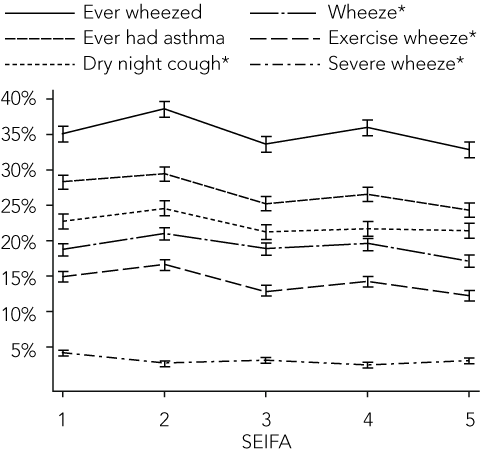 | |||||||||||||||
3 Proportion of the children with wheeze during the preceding 12 months (n = 1472) who had a regular asthma review by a GP, or attended an ED with a wheeze episode, by SEIFA quintile
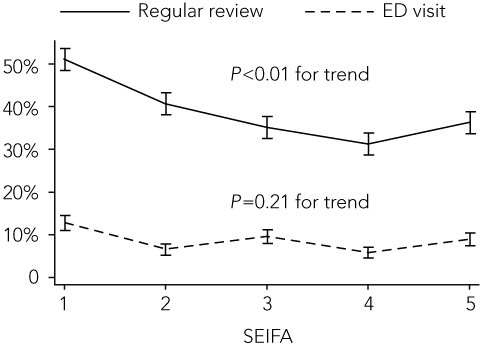 | |||||||||||||||
4 Prevalence (95% CI) of asthma symptoms and use of health care resources among primary school children in coastal, rural and metropolitan zones of the Barwon region
5 Prevalence (95% CI) of asthma symptoms and use of health care resources among 6- and 7-year-old primary school children in Melbourne (2002) and the Barwon region (2005)
Received 26 December 2006, accepted 29 May 2007
- Peter J Vuillermin1
- Mike South1
- John B Carlin1,2
- Maree I Biscan3
- Sharon L Brennan3
- Colin F Robertson1
- 1 Department of Paediatrics, University of Melbourne, Melbourne, VIC.
- 2 Department of Public Health, University of Melbourne, Melbourne, VIC.
- 3 Barwon Health, Geelong, VIC.
We thank the primary schools of the Barwon region, Associate Professor Peter Hewson, The Jack Brockhoff Foundation and The Murdoch Childrens Research Institute for their assistance.
None identified.
- 1. Hanania NA, David-Wang A, Kesten S, Chapman KR. Factors associated with emergency department dependence of patients with asthma. Chest 1997; 111: 290-295.
- 2. Chen Y, Tang M, Krewski D, Dales R. Relationship between asthma prevalence and income among Canadians. JAMA 2001; 286: 919-920.
- 3. Watson JP, Cowen P, Lewis RA. The relationship between asthma admission rates, routes of admission, and socioeconomic deprivation. Eur Respir J 1996; 9: 2087-2093.
- 4. Asher MI, Montefort S, Björkstén B, et al. Worldwide time trends in the prevalence of symptoms of asthma, allergic rhinoconjunctivitis, and eczema in childhood: ISAAC Phases One and Three repeat multicountry cross-sectional surveys. Lancet 2006; 368: 733-743.
- 5. Robertson CF, Roberts MF, Kappers JH. Asthma prevalence in Melbourne schoolchildren: have we reached the peak? Med J Aust 2004; 180: 273-276. <MJA full text>
- 6. Dodge RR, Burrows B. The prevalence and incidence of asthma and asthma-like symptoms in a general population sample. Am Rev Respir Dis 1980; 122: 567-575.
- 7. Asher MI, Keil U, Anderson HR, et al. International Study of Asthma and Allergies in Childhood (ISAAC): rationale and methods. Eur Respir J 1995; 8: 483-491.
- 8. Robertson CF, Bishop J, Sennhauser FH, Mallol J. International comparison of asthma prevalence in children: Australia, Switzerland, Chile. Pediatr Pulmonol 1993; 16: 219-226.
- 9. Mai XM, Nilsson L, Kjellman NI, Björkstén B. Hypertonic saline challenge tests in the diagnosis of bronchial hyperresponsiveness and asthma in children. Pediatr Allergy Immunol 2002; 13: 361-367.
- 10. Michel G, Silverman M, Strippoli MP, et al. Parental understanding of wheeze and its impact on asthma prevalence estimates. Eur Respir J 2006; 28: 1124-1130.





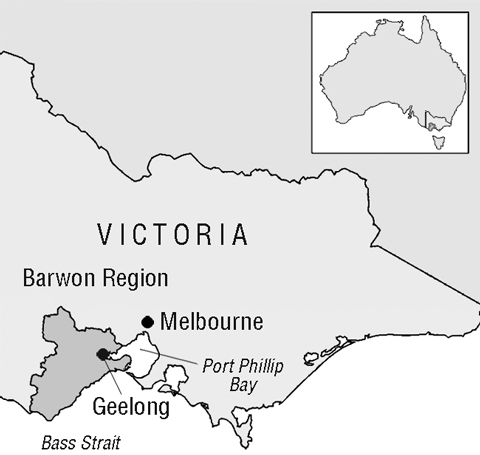
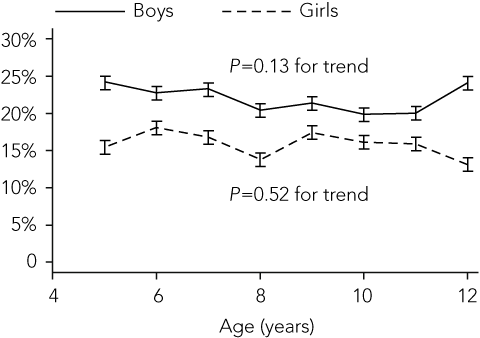
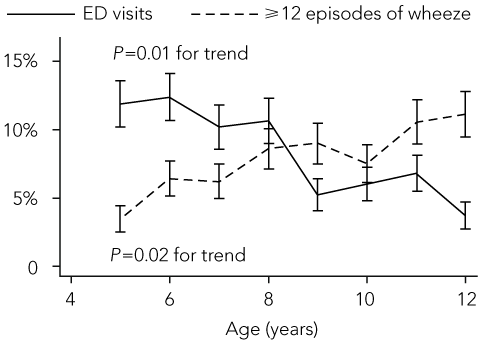
Abstract
Objectives: To determine (i) the relationship between asthma management and socioeconomic status; (ii) whether recent estimates from the International Study of Asthma and Allergies in Childhood (ISAAC) conducted in Melbourne apply to a broader cross-section of Victorian children; and (iii) age-related trends in asthma prevalence.
Design: A questionnaire survey, based on the ISAAC protocol.
Participants and setting: Subjects were children aged 4–13 years from a random sample of primary schools in the Barwon region of Victoria. The survey was conducted between March and September 2005.
Main outcome measures: Parent-reported wheeze and wheeze-related use of health resources during the preceding 12 months.
Results: Questionnaires were returned by 7813/9258 students (84%). Lower socioeconomic status was associated with increased frequency of regular asthma reviews (P < 0.01 for trend), but not of emergency department visits (P = 0.19). The prevalence of wheeze among 6- and 7-year-old children in the Barwon region was similar to that in Melbourne children (20.2% v 20.0%, respectively).There was an age-related increase in the proportion of children with ≥ 12 episodes of wheeze (P = 0.01); but an age-related decrease in emergency department visits (P = 0.02).
Conclusions: Disadvantaged children have good access to regular asthma reviews and are no more likely to attend an emergency department with an episode of acute wheeze. Asthma prevalence in 6- and 7-year-old children in the Barwon region is similar to that in Melbourne. The prevalence of children with very frequent wheeze increases with age, but their use of health resources decreases.